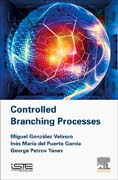
Controlled Branching Processes
González Velasco, Miguel
Garcia del Puerto, Ines Maria
Yanev Petrov, George
Controlled Branching Processes provides a comprehensive discussion of the available results for discrete time branching processes with random control functions. The independence of individuals' reproduction is a fundamental assumption in the classical branching processes. Alternatively, the controlled branching processes (CBPs) allow the number of reproductive individuals in one generation to decrease or increase depending on the size of the previous generation. Generating a wide range of behaviors, the CBPs have been successfully used as modeling tools in diverse areas of applications. Presents a comprehensive analysis of the evolution of discrete branching populations with random control of the number of productive individualsDevelops models of populations subject to simultaneous multiple immigrations and emigration and shows how these can be used to produce a model with any desired equilibrium distributionStudies discrete series of events that can arise in the process of monitoring one population and how the statistics of these events can be characterizedPresents methods for numerical simulation of dynamic populations, giving examples of algorithms that can be used to simulate most of the processes considered in the book, as well as computational intensive methods for estimating the main characteristics of these processes INDICE: 1. Introduction2. Classical Branching Processes3. Branching Processes with Migration4. Controlled Branching Processes : Extinction5. Controlled Branching Processes : Limit Theorems6. Multiple Controlled Branching Processes7. Modified Controlled Branching Processes8. Statistics of CBP : Frequentist approach9. Statistics of CBP : Bayesian approach10. Historical Remarks
- ISBN: 978-1-78548-247-2
- Editorial: ISTE Press - Elsevier
- Encuadernacion: Cartoné
- Páginas: 250
- Fecha Publicación: 01/11/2017
- Nº Volúmenes: 1
- Idioma: Inglés
